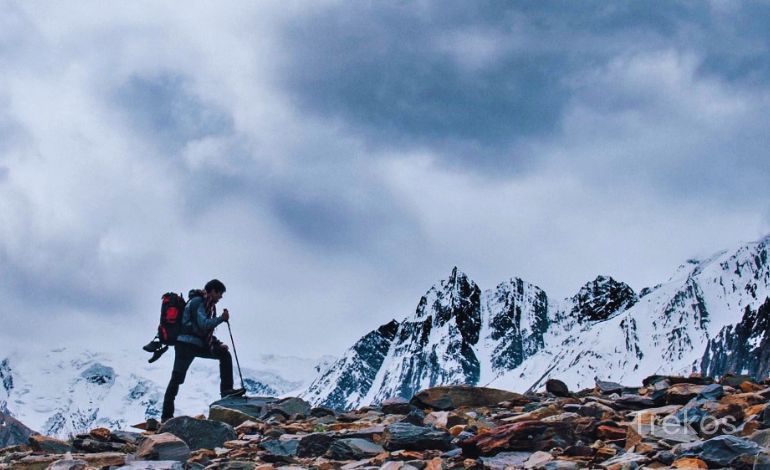
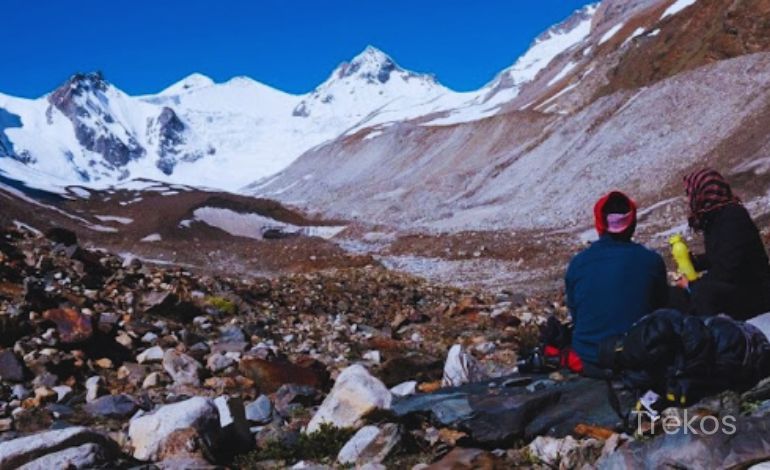
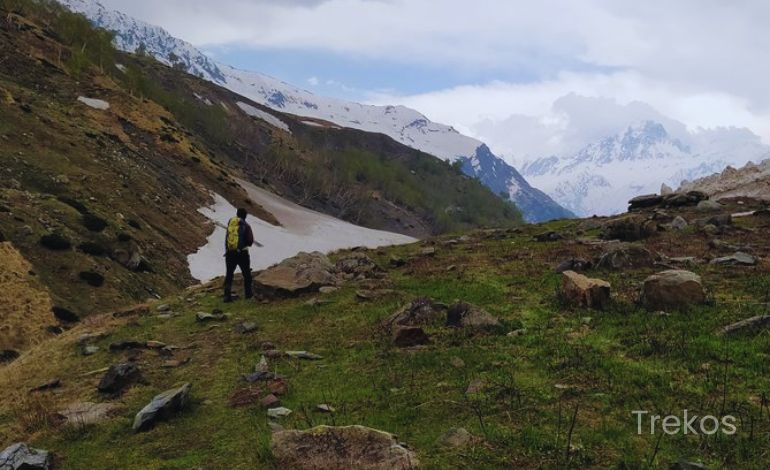
Pick-Up: Harshil & Drop Point: Chitkul
Best season: May To October
Nearest
Airport: Jolly Grant, Dehradun | Railway Station: Rishikesh



Price: ₹28,999/- PP *T&C
+5% GST
Let’s connect with one of the most beautiful treks in the region of Garhwal in Uttarakhand, Lamkhaga Pass Trek. Lamkhaga Pass trek is challenging with high altitude that cuts across the Indo-Himachal border in Uttarakhand. The trekking routes are fully covered by amazing scenery of the Indian Himalayas.
Lamkhaga Pass Trek starts from the beautiful Harshil Village and went to the last village before the Indo-Tibet boder, Chitkul. There are so many pretty villages on the route like- Nagasthi, Rani Kanda, and Dumit-offer a peak into the culture of these amazing villages, also you have the opportunity to know the locals and feel there warm-hearted welcome.
During your Lamkhaga Pass trek package you will pass through “Kyarkoti” which is known as the famous base camp of Black Peak Expedition and after crossing Kyarkoti you have to cross over grounds, hills, hilly high climbs, glaciers, standing stones and finally at the 5280m (17,300 ft.) high Lamkhaga Pass trek to enter in the lovely village “Chitkul”.
While trekking across the different landscapes, Trekos make sure that you can also feel the culture and tradition od the region, Lamkhaga Pass trek package is difficult to moderate and perfect for them who have knowledge of technical trekking. Lamkhaga Pass Trek Package is fully covered by high peaks and wonderful glaciers, also it witnesses the significant height covered in a very short time because of the proper adjustment and a good physical fitness of trekker. The idol season for Lamkhaga Pass trek is from May to June and September to October.
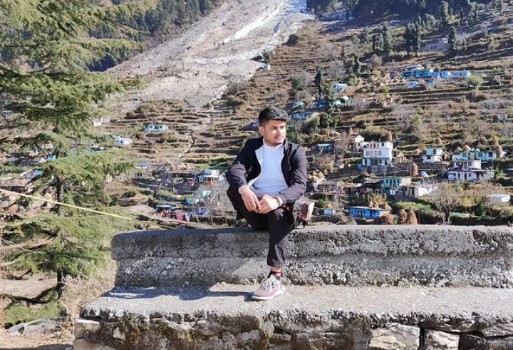


The first day of your trekking in the Lamkhaga Pass Trek Package in Uttarakhand will get you to the fascinating village of Harsil. It is located in the district of Uttarkashi in Uttarakhand, India. Renowned for its serene landscape and tranquility in the atmosphere, Harsil forms an ideal starting point for your expedition.
Upon arrival at Harsil, rest for a while to get your body acclimatized to the altitude. Acclimatization is a must for one’s body to get tuned to the scarcity of oxygen and to avoid altitude sickness. This day can be utilized by one for having some rest, exploring the village, and enjoying the panoramic view of surrounding mountains.
Harsil is mainly famous for its green valleys, picturesque apple gardens, and the serenity of the Bhagirathi River. The evening walk in the village, visits to some of the ancient temples like Mukhba and Dharali village temples to name a few, add to the serene atmosphere.
In the late afternoon, treat yourself to the local cuisine and retire to your guesthouse. Take sufficient rest to begin the Lamkhaga Trek fresh and energetic the next morning.
Also, remember to drink plenty of water and take it easy to allow your body to get used to the elevation. Proper acclimatization is very important for a successful trek. Have all your trekking gear and equipment ready in advance so that you can start this fantastic journey.
The first day of the Lamkhaga Pass Trek Package is designed to introduce one easily to the trail, whereby one prepares their mind and body for the exciting challenges that lie ahead.
The Lamkhaga Pass Trek Package has a journey from Harsil to Kyarkoti on the second day, which covers a distance of about 14 kilometers. The trek is graded as moderately difficult.
The trail starts from Harsil, going in a serpentine way through thick pine and oak forests. The path follows a gradual gain in altitude and presents a panorama of surrounding mountains with views of the cascading Bhagirathi River. It is a gradual climb with some steep sections, so do not forget to take rests and rest stops to keep yourself hydrated.
The time and space to avail yourself of the quiet of the Himalayan natural splendor are plenty on this trek. You’ll be up for a leisurely walk through lush sceneries to the chirping of birds and rustling of leaves. The serene surroundings will offer you serene solace and add to the charm of a trekking experience.
You will reach Kyarkoti, which is at an altitude of about 3,660 meters (12,008 feet), and will find that it is a beautiful campsite. The magnificent view of snow-capped peaks and tranquility makes Kyarkoti famous. Here, you will pitch tents, relax with a heavy meal, and rest after a fulfilling day of trekking.
As night falls, the sky above Karyotin turns into a sparkling starry show. Spend time gazing up at the starry view and contemplate the path led today.
Also, keep in mind to preserve the environment by following Leave No Trace practices.
The Lamkhaga Pass Trek Package on the second day is quite engrossing as there are dense forests and scenic views of nature. It is a sort of initiation into the trail and prepares of Lamkhaga Trek one for the excitement that challenges and rewards will continue.
The third day of the Lamkhaga Pass Trek Package is the one that would take you on a tiring but very rewarding trail from Kyarkoti to the Lamkhaga Pass Trek Package Base Camp. This is a stretch of about 15 kilometers, with quite a substantial altitude gain.
From Kyarkoti, the trail of Lamkhaga Trek is a soft climb out of this interesting landform. You will be doing an ascent or even walking over rocks and meadows sprinkled with beautiful alpines and may cross some snow patches during certain seasons. More, continue high up.
You will have to ascend to the Base Camp by taking steady paces and resting time to time to get acclimatized with the thin air. The Lamkhaga Trek to the Lamkhaga Pass Trek Package base camp includes some demanding sections; hence, you must go easy, be tuned to your body demands, and not take any undue risk.
The trek to the base camp of the Lamkhaga Pass Trek Package at an altitude of about 4,500 meters (14,764 feet) itself leaves any visitor in awe due to its surroundings by high mountain ranges. You will cross it next day to be used as the advent base for the pass.
Tents can be pitched at the Base Camp and one day can be spent at rest and acclimatization. One has to be well-hydrated, intake of proper food, and the urge really has to be from the back of the mind in conserving energy for the next day. The overall feel in this place is totally isolated and quiet with the huge peaks towering over you.
Temperatures will go low at the Base Camp of Lamkhaga Trek as soon as you approach evening hours. Keep yourself warm and ready for a chilling night. Enjoy the calmness of the campsite and its beautiful views; stay out for a few moments before going to sleep.
Day 3 marks an important milestone in your Lamkhaga Trek, bringing you closer towards the Lamkhaga Pass Trek Package. This day takes you further into rugged and dramatic terrain-a preface to the exciting challenge of crossing the pass the following day.
On the fourth dayof the Lamkhaga Trek, excitement reached its peak as you trekked from Lamkhaga Pass Trek Package Base Camp to Lamkhaga Pass, followed by a descent to Gundar. This section amounts to about 12 kilometers and can be said to be the best section of the Lamkhaga Trek.
The tough walk begins from base camp in the early morning hours up to Lamkhaga Pass Trek Package. It’s pretty tough and steep; the trail winds through hard, tough terrain that requires strength and willpower. The panorama changes entirely as you proceed, and the surface gets more rock-strewn and snow can be seen frequently. Normalizing and keeping a balanced speed by taking regular breaks is extremely crucial, as the breath tends to grow heavy at such an altitude.
Trekking up to the Lamkhaga Pass, elevation around 5,282 meters (17,323 feet), gives a great vision across the horizon by recording Himalayan peaks on all flanks. Spend a little pause in the midst of this grandeur of mountains and shoot the awesome vistas of the same in your camera. Generally, an extended view from the pass bestows one with visions and realizations of mountain-range magnitudes and the pristine wildness all around it.
Having relished the panoramic view from the pass, you will begin going down to Gundar. The path proceeds along the magnificent panoramas: gentle grassy slopes, murmuring streams, and a bit of snow there. One is very careful while descending, more so since the difficult landscape might do something bad to a careful foot.
You can set your camp and relax for the night after reaching Gundar. It is a very quite place, enjoying the serenity amidst the towering calm mountains. Relax and gather your thoughts on the day’s success while at the same time indulging in a warm meal before you catch the night’s sleep.
The day is full of adventure, with a share of real challenge and glory. Climbing the Lamkhaga Pass Trek Package is a drenched-and-dried experience with Himalayan elegance and personal pride. The high mountains remain etched in the memory, and one feels one has achieved a lot with regard to endurance.
On the fifth day of the Lamkhaga Pass Trek Package, you will trek from Gundar to Dumti, which is a distance of about 14 km. The landscapes are varied here and representative of the natural beauty and isolation of this region.
Now, you are going to leave Gundar behind and proceed downwards towards this highly captivating wilderness. The route meanders through lush meadows, thick forests, and quaint villages by attractively combining panoramic views with cultural experiences.
Along the way, you’ll cross several small streams on wooden bridges and see all kinds of flora and fauna. Look out for brilliant wild flowers, sweet birdsong, and maybe even some Himalayan wildlife such as mountain goats.
Compared to the previous days, the Lamkhaga Trek from Gundar to Dumti is relatively moderate. The trail is softer though parts of the trek are uphill and others downhill, you get to enjoy the serenity around you better. You will stop over to interact with the locals and experience their culture, as you will pass through several villages end route. You get to try local cuisines along the way, if available.
Upon arrival at Dumti village, set camping-a paradisiacal village nestled amidst mountains. Dumti is a peaceful place; just unwind yourself after a day-long trekking and enjoy interacting with fellow trekkers and food served hot.
Lamkhaga Pass Trek Package has some beautiful landscapes, cultural encounters, and more or less moderate trekking. It is an excellent opportunity to experience the enigma of this remote Himalayan region and to interact with people living on the way.
The Lamkhaga Pass Trek Package on the sixth day will take one on a journey of about 8 kilometers from Dumti to Rani Kanda. This part of the Lamkhaga Trek provides opportunities to see scenic landscapes and the charm of remote villages.
From Dumti, the trail will take you through some of the most picturesque meadows and through thick forests, affording breathtaking views of the surrounding mountain ranges. The consummate beauty of nature will leave you spellbound as you work your way to Rani Kanda.
While you hike, take your time to appreciate the different flora and fauna that exist around this region. Look out for colorful wildflowers, towering trees, and the sweet sounds of birds accompanying you further down the trail.
Compared to the previous days, this day is much shorter and easier; hence, one can have a very relaxed trek. Avail this full opportunity to enjoy the serenity of the surroundings of the Himalayas and enjoy the peaceful ambiance.
On your way, you may be able to find little villages and gain access to the people who reside here. The villagers of these areas are friendly and open-minded; they show you their way of life and culture.
When you arrive at Rani Kanda, a mountain village, you will rest and set up your campsite. The village offers ideal settings for relaxation and contemplation. Have a good meal and also share experiences with your co-trekkers to make memories of the trek forever.
The tranquil surroundings and grand views at Rani Kanda set the perfect environment to rest. One can take this time to get into the majestic mountain views and appreciate the unspoiled beauty of this Himalayan region.
The crossing of the Lamkhaga Pass on Day 6, though tiring, is nonetheless an experience worth going through with its scenic beauty combined with cultural encounter. This is, in fact, a great chance to indulge in the natural beauty of the Himalayas besides acquainting oneself with the locals.
A 9-km-long trek from Rani Kanda to Chitkul falling on the seventh and last day of the Lamkhaga Pass Trek Package would bring you to the end of your trekking spree and turn out apt for concluding the whole thing.
The path leads from a place called Rani Kanda, taking you right through some awesome scenery where the towering mountains stand majestically all around. During the time of trekking, you shall cross meadows, thick forests, and sparkling streams-all offering unique touches to add to the beauty and serenity of nature.
The way to Chitkul unfolds breathtaking vistas-lush green valleys and the glinting Baspa River. Serenity reaching its zenith, when the gurgle of the river mingles with crisp mountain air, making every inch of your system alive as you near the end of your trek.
It is more common to call it the “last inhabited village on the Indo-Tibetan border.” Chitkul is a small, quaint little village situated on the Himalayas. Its landscapes are simply breathtaking, and cultural heritage is in abundance here. Indeed, it extends a warm welcome to all trekkers.
Upon arrival, take a walk around this charming village. The people are friendly, known for their hospitality and traditions full of life. The village has narrow lanes lined with traditional wooden houses, ancient temples, and monasteries.
Relish the local delicacies and feast your eyes with the panoramas of snow-capped peaks and Baspa River flowing alongside Chitkul. It is in this final halt that one can recollect their journey and engage in the local way of life.
After the sightseeing and celebrating the whole day, in the evening, find comfortable accommodation in Chitkul and sleep for the night. Think about your great trek that you have done and the special moments you spent during this trek.
The last day of the Lamkhaga Pass Trek Package is the time to feel proud and celebrate because at this time one can retrospect upon the Himalayas for their beauty and Chitkul for its cultural richness.
By Air: The nearest airport serving Harsil is Jolly Grant Airport, Dehradun, Uttarakhand. One can reach Dehradun Airport by flights from major metropolitan cities like Delhi, Mumbai, or Kolkata. Avail a taxi or shared cab from the airport for Harsil, which is 245 km away. It takes around 8-9 hours with average traffic.
By Rail : The nearest railway station from Harsil is the Rishikesh Railway Station, which is approximately 245 km. Rishikesh can be efficiently accessed by train with key cities across India. A tourist can take a taxi or share a cab from Rishikesh to reach Harsil in about 8-9 hours.
By Road: Harsil is well-connected by road to most cities in Uttarakhand. Regular bus services ply between Rishikesh and Dehradun and Harsil. One can also hire a private taxi or drive down in one’s own vehicle. This road journey, too takes approximately the same time of 8-9 hours from Rishikesh.
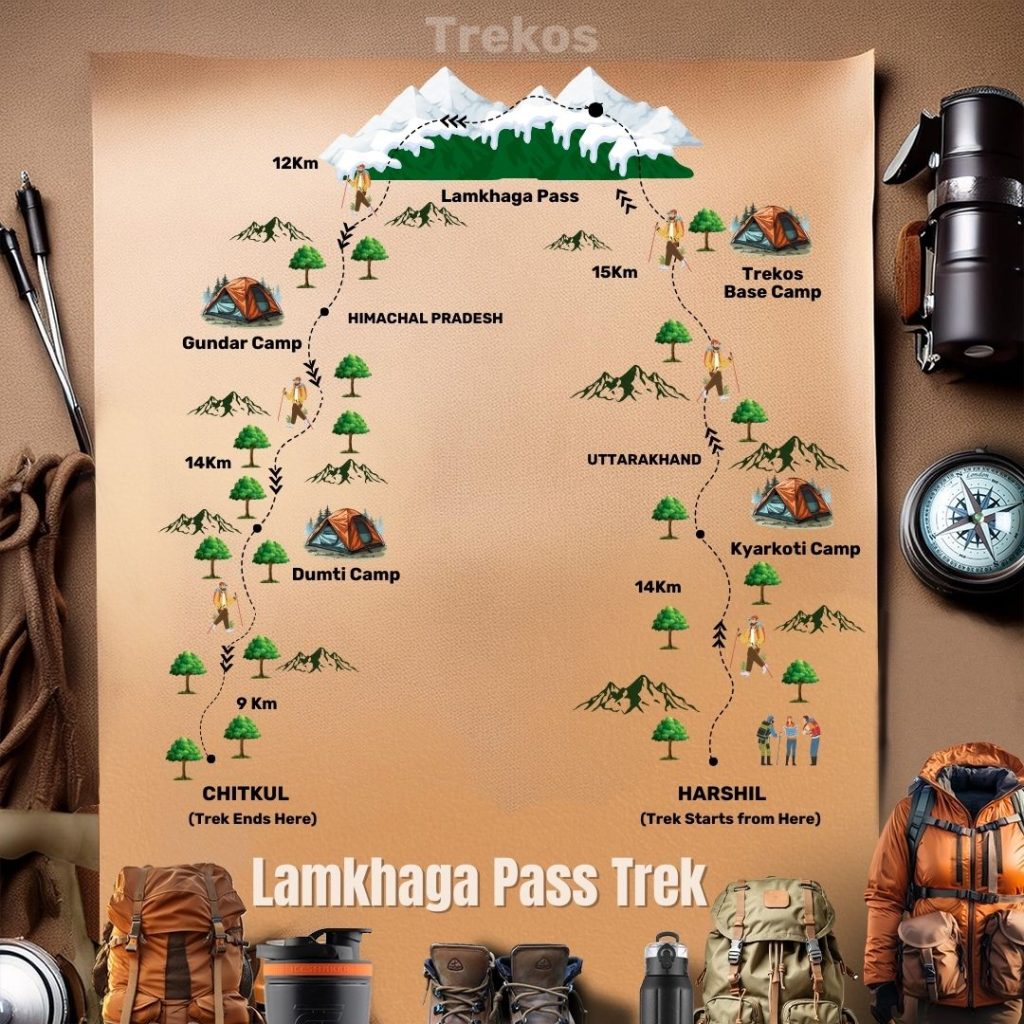
Acclimatization
It is important because the human body stabilizes the level of oxygen inside the body to prevent altitude sickness and to maintain physiological fitness. Take an extra day or so to acclimatize yourself at the base camp, Sankri, or intermediary points. Go upwards gradually to not be overly exhausted in an attempt to expedite the process of reaching your destination sooner. Practice “climb high, sleep low.” For that, one may hike at a higher altitude than one’s camps and spend certain time at that altitude before returning to the campsite. Reduce the strength exercises instead; practice yoga or any other slow breathing exercises, such as Pranayama.
Weather Preparedness:
The weather in Lamkhaga Pass Trek is quite dubious, with a high chance of snowfall and extreme cold. It helps you to know in advance about the weather to plan your trek well and be prepared for any kind of sudden climatic change. Guides will regularly check the weather forecast. Prepare for rain changes at any time with items like a waterproof jacket or a poncho and extra quick-drying socks. The goal is to attempt to start and complete your hikes in the morning and/or afternoon to avoid afternoon rain showers. Should it begin raining, stop and take a break but, during this time, avoid sitting around streams or riffle areas. Avoid crossing these either, unless absolutely necessary.
Hydration and Nutrition:
Hydration and nutrition are the trekkers’ key to energy and health on the trek. Drink plenty of water throughout the day. Snacks to carry include high-energy, easily digestible things like nuts, energy bars, and fruits. Avoid beverages with alcohol and processed foods and drinks with sugar because they will fatigue through a reactive drop in blood sugar levels.
Health and First Aid:
Timely response to health issues can prevent serious complications. Always carry a comprehensive first aid kit with altitude sickness medications and know basic first aid procedures. Inform your trek leader about any previous health conditions.
Safety Gear:
The right gear will eliminate many injuries and keep you safe in bad conditions. Wear tough, waterproof, broken-in trek shoes with good ankle support. Wear varied layers to maintain body temperature, mainly above the Lamkhaga Pass trek package Base Camp. A tough backpack is required, with a rain cover and headlamp, along with rope, oxygen cylinder, gaiters, and micro spikes.
Emergency Preparedness:
Quick, immediate action in case of an emergency. The nearest hospital is in Mori, which is at a distance of 21 km from the Sankri Base Camp. Ensure that your trek leader has means of communication such as a satellite phone or walkie-talkie. Get an adventure insurance that covers high-altitude trekking.
Trail Safety:
Trekking through snowy trails is an art which calls for caution and skills. One should not go outside the tour guide’s set boundaries but follow marked trails; a compass, maps, or GPS devices can be used in case there is a fear of getting lost. Follow trail markers and do not leave the path.
Wildlife Awareness:
Wildlife encounters are hazardous. Distance from animals should be maintained. Store food in a secure place and clean up the campsite to avoid attracting wild animals’ attention.
Group Coordination:
This is one of the most vital ways to remain connected with the group for overall safety. Stay in close contact with your group at all times. Listen to every word of your trek guide and never stray away from the group.
Care for the Environment:
Care for the natural environment is extremely important. “Leave No Trace” principles should be followed. Dispose of garbage properly and avoid disturbing the wildlife and vegetation.
Altitude Sickness:
Short of breath, headache, nausea and dizziness. In case of any symptom, inform your trek leader immediately. Descend to a lower altitude if needed and take medical help if the symptom doesn’t subside. On Laamkhaga Pass Trek, after crossing base camp 11250 feet, some trekkers are found with AMS. Up to the summit, a slow and steady pace needs to be kept.
40% Advance and Balance at the time of trip start.
We understand that planning an outdoor trip brings a lot of excitement and joy. However, we also know that cancellations can be disappointing. While Trekos rarely cancels treks due to our efficient ground operations, cancellations can happen due to unforeseen circumstances such as weather conditions, government regulations, or any other factors beyond our control. In such cases, the following cancellation policy will be applicable.
To ensure a hassle-free experience, we recommend making your booking at least two months in advance. If you do need to cancel your trek, please inform us in writing. Cancellation charges will be effective from the date we receive written advice.
Our cancellation policy is as follows:
We have designed a cancellation policy that is fair, feasible, and convenient for all our customers. The procedure is as follows:
We also have some terms and conditions for the trek voucher:
Lamkhaga Pass Trek Package is a trek across the Garhwal Himalayas connecting the village of Harsil in Uttarakhand to Chitkul-the last village before the Indo-Tibet border in Himachal Pradesh. The Lamkhaga Trek weaves through the picturesque district of Uttarkashi in Uttarakhand and offers an enchanting journey between the two regions.
Of special mention is the Lamkhaga Pass, ascending to about 5,280 m—a highlight of Lamkhaga Pass Trek—the trail spans the different associated terrains: scree-sloped, moraine-swept slopes, steep climbs, crevassed glaciers, and boulder pilgrimages before the eventual entrance into the pass. It then heads to the village of Chitkul, the last inhabited settlement before the Indo-Tibetan border. On the way, you will be experiencing all the types of vegetation, starting from the meadows and forests to alpine belts. The Lamkhaga Trek also offers numerous opportunities to visit beautiful hamlets and interact with their people, enjoying their culture and lifestyle.
The best months to visit while crossing the Lamkhaga Pass for the trek are May, June, September, and October.
The Lamkhaga Pass Trek Package is suitable only for experienced trekkers since it has an exhausting terrain and altitude. This Lamkhaga Trek requires immense physical fitness, endurance, and experience in previous trekking. Hence, beginners are advised to gradually develop their trekking skills and improve their fitness to tackle the challenging Lamkhaga Trek.
The permits are required for the Lamkhaga Pass Trek Package, which you will need to procure from the relevant authorities, involving the local forest department and the Indian Mountaineering Foundation-IMF. For the most updated information on obtaining permits, if at all possible, consult the local trek organizers or official authorities.
Available Dates
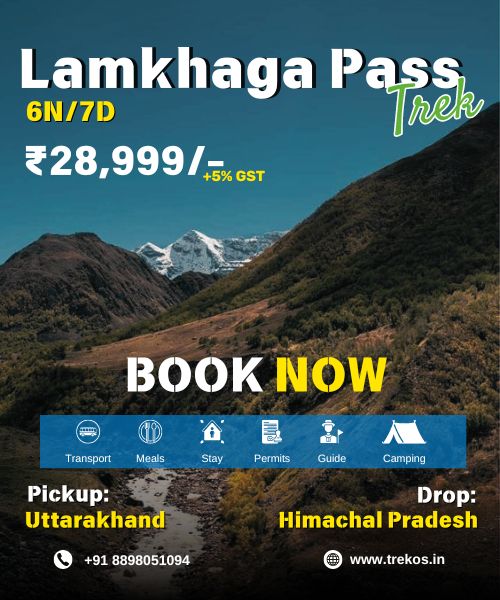
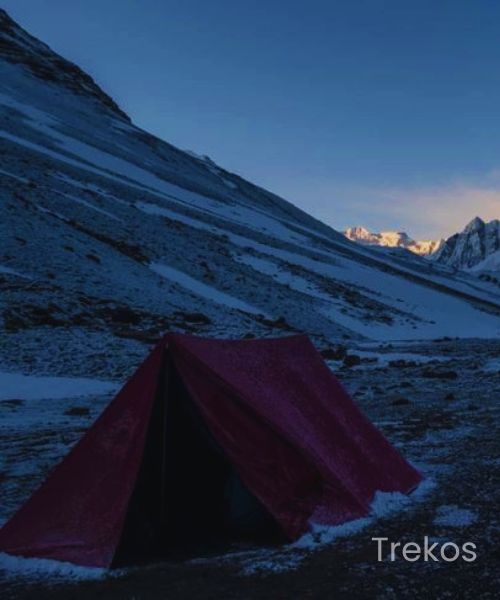
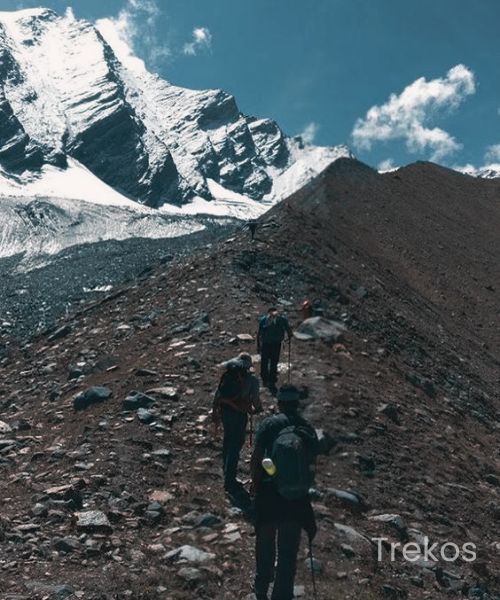
Enquiry Form
Call Now: +91-8868051094
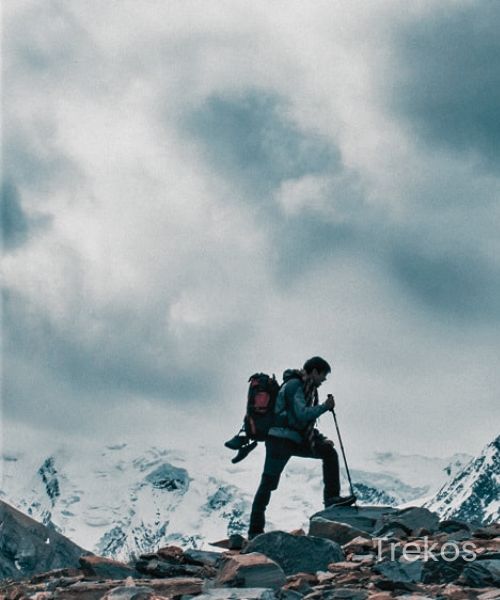
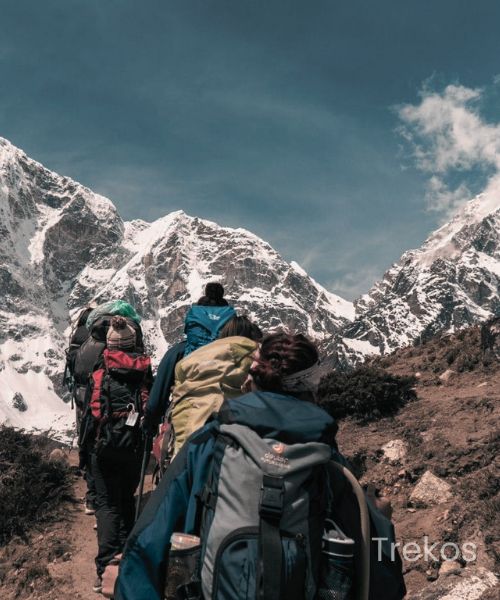
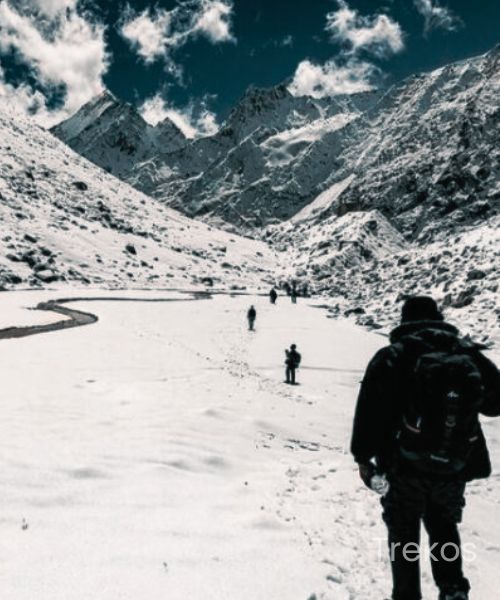
Lamkhaga Pass Trek Blogs
Other Blogs
Over 20,000 people trek with Trekos yearly and vouch for our unmatched safety standards. See what they have to say below. Click to read more.
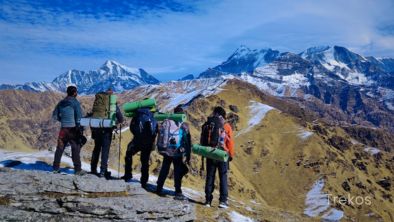
Ali Bedni Bugyal
Ali Bedni Bugyal Trek is a beautiful trek in Uttarakhand, India, known for its lush green meadows (bugyals) and stunning views of the snow-capped Himalayan peaks like Trishul and Nanda Ghunti. The memorable memory for the life.
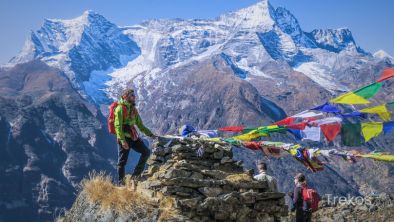
Chopta Tungnath Trek
The Chopta Tungnath trek is a scenic and relatively easy trek in Uttarakhand, India, known for its breathtaking views and rich natural beauty. Highest Shiva temple in the world offers panoramic views of majestic peaks like Nanda Devi, Trishul.
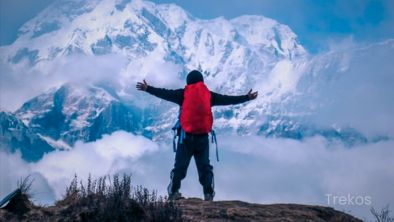
Kedarkantha Trek
The Kedarkantha trek is a popular winter trek located in the Garhwal Himalayas of Uttarakhand, India. Swargarohini, Black Peak, and Bandarpoonch. The best time to visit on this trek is from December to April. The journey typically takes around 5-6 days.
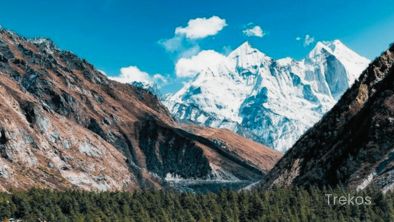
Gaumukh Tapovan Trek
Gaumukh Tapovan Trek, located in the Garhwal Himalayas of Uttarakhand, has both scenic and spiritual values imbibed within it. The best part of the trek is the final destination, the mythical source of the Ganges at Gaumukh, the Gangotri Glacier stretching 4,000 meters above sea level.
Welcome to

Welcome to

Welcome to
